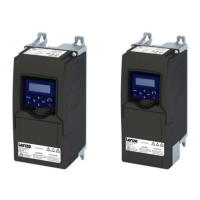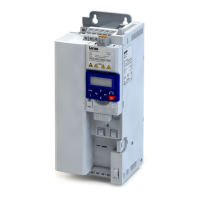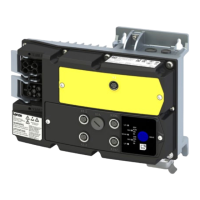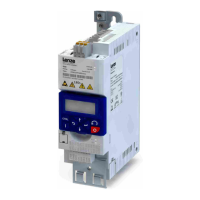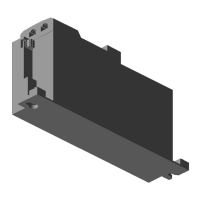8.3.4 Slip compensaon
In case of a load, the speed of an asynchronous motor decreases. This load-dependent speed
drop is called slip. The slip compensaon serves to counteract the load-dependent speed loss.
Precondions
The funcon is only eecve in the motor control type "V/f characterisc control (VFC open
loop)".
In order that the funcon can determine the rated slip correctly, the following parameters
must be set correctly:
•
Rated speed
•
Rated frequency
•
Number of pole pairs (Automacally calculated from Rated speed and Rated frequency)
Details
The slip compensaon increases or decreases the output frequency as a response to a load
change. Thus, the slip is counteracted and the speed is kept precisely.
Output frequency
Load
Motor speed
The rated slip required for the slip compensaon is calculated by the inverter according to the
following formula:
Rated slip [%] = (1 - (rated motor speed [rpm] / (120 * rated motor frequency [Hz] / number of
poles))) * 100
Calculaon example:
•
Rated motor speed = 1750 rpm
•
Rated motor frequency = 60 Hz
•
Number of poles = 2 * Number of pole pairs = 2 * 2 = 4
•
Rated slip = (1 - (1750 / (120 * 60 / 4))) * 100 = 2.77 %
The rated slip represents the reducon of the motor speed due to the motor load. At full
speed and full load, the motor given in the example would rotate with 1750 rpm, which
means 2.77 % below its synchronous speed of 1800 rpm. In order to compensate this speed
loss, the inverter increases the output frequency by the rated slip mulplied by the rated
motor frequency. In the example 2.77 % * 60 Hz = 1.66 Hz increase at full load.
In order to consider load changes, the inuence of the rated slip on output frequency can be
adapted in 0x2B09:001 (P315.01). A seng of 100 % corresponds to the rated slip of the
machine in the nominal operang point.
With reference to the example above and a setpoint frequency of 60 Hz:
•
If 0x2B09:001 (P315.01) = 100 %, the output frequency is = 61.66 Hz
(60 Hz + 100 % * 1.66 Hz).
•
If 0x2B09:001 (P315.01) = 50 %, the output frequency is = 60.83 Hz
(60 Hz + 50 % * 1.66 Hz).
Addionally, the lter me for the slip compensaon can be adapted in 0x2B09:002 (P315.02)
if required. The preset lter me is adapted to typical motors. If full load or nearly full load
oscillaons or instabilies occur, we recommend an increase of the lter me.
Parameter Name / value range / [default seng] Info
0x2B09:001
(P315.01)
Slip compensaon: Gain
(Slip compens.: Slip: gain)
-200.00 ... [100.00] ... 200.00 %
Adjustment in percent of the slip calculated.
•
For instance required for deviaons of the real motor data from the
nameplate data.
•
A seng of 100 % corresponds to the rated slip of the machine in the
nominal operang point.
0x2B09:002
(P315.02)
Slip compensaon: Filter me
(Slip compens.: Filter me)
1 ... [100] ... 6000 ms
Filter me for the slip compensaon.
•
The preset lter me is adapted to typical motors.
Motor control
Opmisaon of motor control
Slip compensaon
135
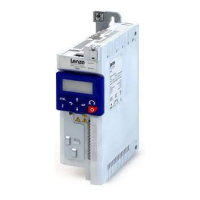
